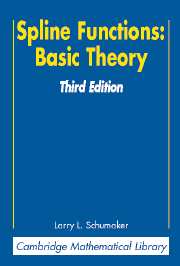Book contents
- Frontmatter
- Contents
- Preface
- Preface to the 3rd Edition
- Chapter 1 Introduction
- Chapter 2 Preliminaries
- Chapter 3 Polynomials
- Chapter 4 Polynomial Splines
- Chapter 5 Computational Methods
- Chapter 6 Approximation Power of Splines
- Chapter 7 Approximation Power of Splines (Free Knots)
- Chapter 8 Other Spaces of Polynomial Splines
- Chapter 9 Tchebycheffian Splines
- Chapter 10 L-Splines
- Chapter 11 Generalized Splines
- Chapter 12 Tensor-Product Splines
- Chapter 13 Some Multidimensional Tools
- Supplement
- References
- New References
- Index
Chapter 1 - Introduction
Published online by Cambridge University Press: 06 January 2010
- Frontmatter
- Contents
- Preface
- Preface to the 3rd Edition
- Chapter 1 Introduction
- Chapter 2 Preliminaries
- Chapter 3 Polynomials
- Chapter 4 Polynomial Splines
- Chapter 5 Computational Methods
- Chapter 6 Approximation Power of Splines
- Chapter 7 Approximation Power of Splines (Free Knots)
- Chapter 8 Other Spaces of Polynomial Splines
- Chapter 9 Tchebycheffian Splines
- Chapter 10 L-Splines
- Chapter 11 Generalized Splines
- Chapter 12 Tensor-Product Splines
- Chapter 13 Some Multidimensional Tools
- Supplement
- References
- New References
- Index
Summary
The first three chapters of this book are devoted to background material, notation, and preliminary results. The well-prepared reader may wish to proceed directly to Chapter 4 where the study of spline functions per se begins.
APPROXIMATION PROBLEMS
Functions are the basic mathematical tools for describing and analyzing many physical processes of interest. While in some cases these functions are known explicitly, very frequently it is necessary to construct approximations to them based on limited information about the underlying processes. Such approximation problems are a central part of applied mathematics.
There are two major categories of approximation problems. The first category consists of problems where it is required to construct an approximation to an unknown function based on some finite amount of data (often measurements) on the function. We call these data fitting problems. In such problems, the data are often subject to error or noise, and moreover, usually do not determine the function uniquely. Data fitting problems arise in virtually every branch of scientific endeavor.
The second main category of approximation problems arises from mathematical models for various physical processes. As these models usually involve operator equations that determine the unknown function, we refer to them as operator-equation problems. Examples include boundary-value problems for ordinary and partial differential equations, eigenvalue–eigenfunction problems, integro–differential equations, integral equations, optimal control problems, and so on. While there are many theoretical results on existence, uniqueness, and properties of solutions of such operator equations, usually only the simplest specific problems can be solved explicitly.
- Type
- Chapter
- Information
- Spline Functions: Basic Theory , pp. 1 - 11Publisher: Cambridge University PressPrint publication year: 2007



